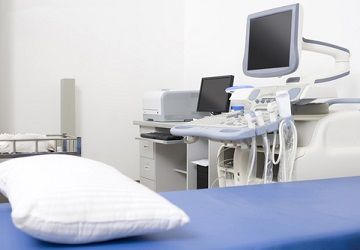China Emerging as a Land of Dental Business Opportunity
China's burgeoning middle class is demanding oral healthcare. A KPMG report estimates that there will be more than 42,000 dental care delivery organizations in China by 2020.

Reports indicate that the Chinese dental market is poised for rapid growth.
Entrepreneurial dental school graduates may be heading east to find work, if prevailing market trends bear out. And that doesn’t mean setting up shop on the East Coast — much farther east than that.
China, where a growing economy and demand for treatment are fueling growth in the dental care and product market, is on its way to becoming a new land of dental opportunity.
Consider there were more than 29,000 dental care delivery organizations in China in 2014 generating U.S. revenue equivalent of slightly more than $4.4 billion, approximately half of which was from the private sector, according to an October 2016 KPMG report, “Commercial Opportunities in the Dental Care Market in China.” At the market’s current growth rate, it’s estimated there will be more than 42,000 dental care delivery organizations by 2020.
Those numbers suggest significant opportunity, but the market is not without challenges. A shortage of skilled practitioners and access to quality care are among the most prevalent problems. For example, the number of registered dentists in China nearly tripled between 2010 and 2013 to 130,000. Despite that growth, there was still only one dentist per 10,000 people in 2013.
“A lot of Chinese (dentists and dental students) want to travel abroad to learn,” says Robert Ord, DDS, MD, FRCS, FACS, MS, chairman of the Department of Oral-Maxillofacial Surgery and professor at the University of Maryland School of Dentistry. “The problem is that not all of them go back.”
Despite those and other challenges, the Chinese dental care market is expected to grow significantly as competition within the market increases.
Assessing the Landscape
In addition to the shortage of dentists, the treatment rate is low. The most recent National Surveillance Studies of the Population Dental Health, conducted in 2005, indicate that the prevalence of caries in China was 66 percent among children aged 5; 28.9 percent among children aged 12; 88.1 percent among adults aged 35-44; and greater than 98 percent among adults aged 65 to 74. However, treatment rates were as low as 3 percent for children aged 5, and 11 percent for those aged 12.
The challenge of reducing those incidences could become more pronounced given China’s 2015 decision to scrap its one-child policy after 35 years in response to an aging population.
“I suspect that’s going to bump their birth rate,” Ord says. “There could be a sort of mini-explosion.”
But Pei Feng, MD, PhD, a professor in the Department of Oncology and Diagnostic Sciences and director at the University of Maryland School of Dentistry, isn’t sure, given how expensive it is to raise children. However, she says the booming Chinese economy and expansion of the middle class has been accompanied by an increased focus on the importance of oral hygiene.
“The older generation of Chinese people previously lacked routine dental and dental hygiene care,” Feng says. “But for many years they were allowed only one child per family, so they really focused on children’s dental care, dental hygiene, and early correction of orthodontic treatment for children.”
That growing middle class, says Yen Li, public relations manager with Oral Care RBU Communications, an affiliate of Proctor & Gamble of Greater China, is increasingly demanding professional oral care.
“They care more about their health and quality of life, and chase forward-looking and revolutionary knowledge and products,” Li says.

Public hospitals address much of the need for dental care in China.
Access Issues
Part of the access to care problem stems from the structure of China’s social insurance program, where coverage is limited to basic treatments. Patients are encouraged to choose private clinics — where there are shorter wait times and more flexibility in appointments – versus public hospitals when having to foot the bill themselves. However, the shortage of dentists is more severe in the private sector where the facilities are seen as less prestigious.
Private clinics also represent a smaller portion of the overall care delivery market: 42 percent compared with 57 percent for stomatology departments in general hospitals. Consequently, these public hospitals experience 50 percent of the overall dental patient volume compared with 20 percent for private clinics.
And then there’s the catch-up factor.
“In China you have places like Shanghai where you can go and get the best healthcare in the world, including dentistry,” Ord explains. “On the other hand if you go to rural China it’s back 200 years.”
In that respect, Ord says China is not unlike the U.S. where there’s a doctor or dentist on every corner in Washington, DC, but it’s vastly different in rural North Dakota. These disparities are more magnified in China.
“The country only started to grow and take off in the last 30 or 40 years, and they’re trying to catch up now with areas that have been established in the west for 100 years,” Ord says.
There’s also the cost factor. Dental services, the KPMG report indicates, are paid in three ways: social insurance, commercial insurance and out-of-pocket payments. With social insurance covering only basic treatments, and demand growing for orthodontics and dental implants, some insurance companies are collaborating with dental implant service providers on a plan with a fixed fee, usually around the U.S. equivalent of $1,300 per tooth. These plans are gaining popularity, and dental practitioners indicate they are contributing to a “significant effect on the dental implant market.”
But the Chinese are also willing to pay to alleviate the pain associated with dental problems, Feng says. As a result, even though profit margins for dentists in China are relatively lower than in the U.S. for the same or similar procedure, the need for treatment and size of the population offset the smaller reimbursement.
“The patient flow at a dental clinic is much heavier than in the U.S.,” Feng explains. “Each dentist can probably see 20 patients a day.”
Continuing Education
In 2014, Chinese dental schools graduated more than 5,200 students. That number is expected to grow by 4 percent a year to more than 6,600 in 2020. But there is clearly a need, and opportunity, for more growth in this area.
As one might expect, all registered dentists in China need to participate in continuing education courses. They are required to earn 25 credits annually to maintain their license status. But there is also a need for higher education among dental school graduates.
According to the National Health and Family Planning Commission in 2012, nearly 47 percent of registered dentists held a professional degree at bachelor’s level or higher. However, fewer than 10 percent of those degrees were at the master’s level or above. As such, the majority of registered dentists (53 percent) work in less developed regions and clinics.
In an effort to fill that education need, in October 2015 a team of faculty from Harvard School of Dental Medicine’s Division of Periodontology offered the first continuing education course at the Harvard Center Shanghai. The course, “A Comprehensive Guide to Advanced Implant Dentistry,” enabled dentists to participate in a collaborative learning environment. A series of courses is planned to expand educational programs in China, including “a comprehensive Approach to Esthetic Dentistry” which is planned for April 2017.
The University of Maryland School of Dentistry also has an exchange program. In December 2015 representatives from School of Stomatology Shanghai Jiao Tong University had a 10-day visit that included an opportunity for hands-on experience with the School of Dentistry’s Computer Aided Design/Computer Aided Manufacturing equipment.
“They know about this technology, but they are not exposed to it during their dental education,” said Gary Hack, DDS, clinical associate professor in the Department of Endodontics, Prosthodontics and Operative Dentistry at Maryland.
During the same month, a contingent of 17 dentists in private practice from across China toured the University of Maryland School of Dentistry, as well as campuses at MIT, Harvard and Columbia Universities, as part of an effort to find continuing education opportunities in the U.S.
Feng, who took part in the visit, says the university’s “major goal is the global engagement of dental education.”

The door remains open to new entrants to the traditionally internationally dominated Chinese dental equipment market.
Dental Equipment
The size and growth potential of the dental equipment market in China is significant. According to the KPMG report, the market, which is estimated to have reached more than $1.8 billion in equivalent U.S. currency in 2015, is expected to triple in size by 2020, thanks in large part to the rapid growth of dental care organizations.
The dental equipment market is currently dominated by international brands, including Sirona, Kavo, Yoshida and Morita. However, the door remains open for new entrants in the dental equipment market, particularly in the area of dental implants — a relatively new and growing segment of the market. Specialists in this market believe that new entrants with lower prices will be able to win market share.
On the consumer side, a growing middle class that is paying increased attention to quality of life is a prime target for oral health products. An article on ChinaDaily.com indicates that American oral hygiene brand Oral-B has introduced a new intelligent electric toothbrush priced at the U.S. equivalent of $302. “One thousand sets were sold within three hours after it launched on Alibaba Group Holding’s Tmall.com,” which is one of the country’s largest e-commerce shopping websites, according to the article.
P&G’s Li says one of the keys to success of the intelligent electric toothbrush, called the iBrush, is understanding Chinese consumers’ oral care habits.
“P&G scientists in the Beijing Innovation Center are responsible for conducting research in different directions,” Li explains. “For example, Chinese consumers’ habit of brushing teeth, the average time of brushing, the status of oral health, and how to help keep consumers brushing for a longer time to develop better habits are studied.”
Consumer preference for receiving information is also an important consideration. Li says that in order to better understand these habits, Oral-B engaged the services of Wangkai (an A-list celebrity in mainland China) as the brand spokesman.
“We’ve leveraged the influence of Wangkai through social media, network media and e-commerce platforms to effectively build a strong relationship with consumers,” Li says.
Given that only two percent of Chinese residents currently use electric toothbrushes, compared with between 35 and 40 percent in the U.S., the opportunity for future growth is significant. A report from Radiant Insights indicates that China’s oral care products market should reach more than $3.2 billion in the coming years.
Future Considerations, Cautious Optimism
Ord says the Chinese may be more focused on research rather than clinical work.
“(The Chinese) have many excellently trained individuals who are researching aspects of oral health prevention, oral healthcare,” he explains. “We’re looking to set up that liaison and form research collaborations.”
Despite the opportunities that exist, and the growth that is occurring, one obstacle that may always remain is China’s political environment. Ord recalls a conversation with the chairman of a medical college in Peking. The associated hospital is multi-storied and state-of-the-art, and includes a VIP tower.
“In my innocence I asked him, ‘Do you have a lot of rich Saudis and others coming in?’” Ord says. “He said no. (The VIP tower) is for members of the Communist party. So, it’s kind of interesting in a Communist regime that preaches equity. It’s like ‘Animal Farm,’ where all animals are equal.”
ACTIVA BioACTIVE Bulk Flow Marks Pulpdent’s First Major Product Release in 4 Years
December 12th 2024Next-generation bulk-fill dental restorative raises the standard of care for bulk-fill procedures by providing natural remineralization support, while also overcoming current bulk-fill limitations.